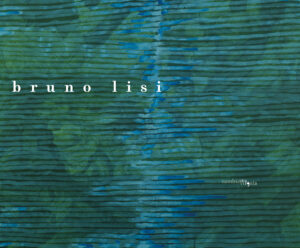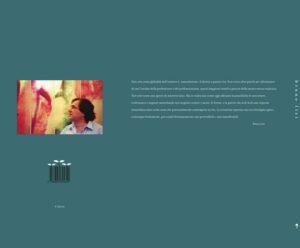Around 2009 I began a more regular association with Bruno Lisi (Rome 1942-2012) and the Associazione Operatori Culturali Flaminia 58 (AOC F58) of which he was president. AOC F58 brings together a small community of artists with studios nestled in the Borghetto Flaminio, round the corner from Piazza del Popolo, in Rome. They have been running regular exhibitions since 1988.
When I visited, I would often find Bruno attending to some new work (a collage), with a scattering of magazine cut-outs, not yet pasted, against the white cardboard on his desk. A lot of them involved segments of women’s heads of hair, typically brunettes, which he rendered almost abstract by combining with other collage elements amid intricate patterns penned in Indian ink. While his application to scissors and paste was reminiscent of the cutting in colour of the elderly Henri Matisse, the dissection of female features had about it something disquieting, even when they became almost unrecognisable in the finished works, as we see in the series Corpi estranei (2008-2009), to which Patrizia Ferri refers in terms of energy agglomerates and tattoos,1 and Senza titolo (2011-2012). From the vantage point of early observations that were essentially fortuitous and subjective, a tendency to linearism emerges in Lisi’s overall production at the root of which is some feminine detail: it is from such intuition that these notes develop.
Trained at the Rome Istituto Statale d’Arte under Alberto Ziveri, Lisi began with works in which abstraction and figuration coalesce, as Cancello verde (1962) suggests, just as the impetus of Arte Informale was spending itself.2 The works he brought to his early solo exhibitions, in the early sixties, were investigations of the female body: squarely and plainly rendered, at first, then elusively evoked by mere hints, with the anatomy serving almost as pretext. In the accompanying text to the 1969 exhibition at the Galleria 88, in Rome, Venturoli spoke of paintings that tend towards a «monochrome palette, something between white and pink, which has an unmistakable suggestion (or memory) of the nude».3 This fidelity to the nude, a canonical theme in painting and a mainstay of Lisi’s production, was to lead to especially accomplished works in the seventies.
In Figura nella spiaggia (ca. 1964), the nude is foregrounded and the painter indulges in sustained observation (while himself remaining, perhaps, unseen). This same impulse to watch closely is at work as the artist lingers on a curled-up and faceless body (Ritorno, 1971), then homes in on more detailed views: an eye, or mouth, and finally on certain ciliate entities – seemingly a combination of lips and labia, or cells on a microscope slide (Senza titolo, 1973-74).
Such proximity of observed and observer could read perhaps as a pornography of the gaze in which the inspection occurs at close range, seeks to explore beyond the bounds of the visible, and surveying devices probe deeply and trespass all dark recesses.
As such, this viewing impulse is certainly a male trait; as it is also constitutive of a social order in which everything from biomedical technology to public surveillance systems is geared to ensure total visibility.
Besides, female lips, mouths, and smiles had been canonical with those artists whose work was modelled on the advertising world and serialised poster images.
Visual poets like Luciano Ori and other artists like Umberto Bignardi took due note of cosmetics ads and incorporated them into their art. Then there came such alluring, singled-out details as in Pino Pascali’s Primo piano labbra (1964), or, in the same year, the great lips in Claudio Cintoli’s mural Giardino per Ursula, designed for Rome’s Piper Club. Pascali further rendered an Omaggio a Billie Holiday (1964) with projecting lips, whereas the Lips sofa designed for Gufram by Studio65, in 1970, came with its promise of seductive home comfort. Not to mention the ironic irreverence of John Pasche’s tongue and lips logo for the Rolling Stones (1971), echoed visually in Lisi’s profile of tongue and florid lips (Metamorfosi Virus, 1972), though tending rather, with Lisi, to spontaneous or erotic posturing than cheekiness.
It is no surprise that the early seventies should find Lisi in thrall to the almost obsessive spell of a young woman’s lips. With forerunners in the creations of the Rome pop art milieu, but decidedly more eroticised, Lisi’s mouths incline towards Hyperrealism, with a glossy, reflective varnish that openly declares itself as paint and droplets of colour in semblance of saliva. Eschewing the mediation of photographs and transparencies (characterising, instead, the modelling of art on serialised media images) Lisi’s mouths stand out as life drawings based on the real.
At about the same time as the sensational mouths (a synecdoche of woman, one might say), Lisi was working on eyes that are just as flamboyant and have a faint outline of lashes (there are five serigraphs on display, from 1971). These lashes and, slightly later, the fine hairs contouring the ovoid entities in the series Senza titolo, 1973-74 (see above) came to morph and into their own, we might say, as the wiry lines that formally define the series Stele (1989- 1991), in coloured biro pen; or to elongate, in a more disciplined manner, in the richly diversified array of Otranto (1993-1994),4 with the sea-waves, beaches, wind-carved boulders, and ploughed fields of a part of the country to which he was deeply attached. His linearist aesthetic continued into the variations of Segno aperto (2003) and Tensioni (2004), where metal wires flow fluidly, congealed in the square-angled blocks of transparent acrylic resin, like living organisms crystallised in amber.
Over the years, Lisi kept innovating, and yet his output remained slightly asynchronous from the current trends, following an independent and solitary course.
Taken in its entirety, one senses the play on variations and allusions form a continuum as his apparent subjects range from observations from nature to dissections of the human figure so closely viewed that the resulting image is at times uninterpretable. Thus, the series Senza titolo (1972- 1973) and Senza titolo (1974) reach, we might say, under our skin and into our own cells. From the eighties on, while continuing to paint, Lisi shifted to a repertoire that is less figuratively involved – still echoing naturalism in his blue monochromes, then working on the potential for variation of the sheer linear mark. His emancipation from figurative strictures is synonymous with freedom, a setting of the art canon at zero.5 This ideal line of development is reflected in the display, arranged as two sets within the one hall of the Museo Laboratorio d’Arte Contemporanea della Sapienza and in keeping with their chronology.
The exhibition further extends to the Museo dell’Arte Classica, where, mirroring the 2003 installation Segno aperto at the Studio d’arte contemporanea Pino Casagrande, the free-standing canvases Segno (1994-1997), Gesto (2000-2001), and Segno aperto (2003-2005) are on view in a suspended display engineered and realised by Luigi Battisti. Finally, among the magnificent university collection of plaster casts, Camilla Boemio has arranged a selection of British video installations and performance art to act as a companion to the work of Lisi.
Across the two venues, the viewer gains a comprehensive view of the main landmarks of Lisi’s career, as the exhibition bears witness to his serial manner of proceeding and increasing preference for paper surfaces. The exhibition would not have been possible without Irene Ranzato’s initiative, constant dedication, and unique expertise regarding the artist and his work.
I wish to thank, for the fruitful exchanges and the information, Mauro Folci, Irene Ranzato and Enzo Rosato.
(translated by Mattia Bilardello)
- 1 See P. Ferri, Lisi Corpi estranei, in exhibition catalogue, Miralli, Viterbo 2009, now in Art under his skin – Patrizia Ferri (page last visited Dec. 10, 2021).
- 2 See L. Trucchi, Un dipingere breve, in F. Moschini (ed.), Bruno Lisi. Opere dal 1989 al 2001, exhibition catalogue, Tilligraf, Rome 2001, pp. 97-98.
- 3 M. Venturoli in Bruno Lisi, exhibition catalogue, Biella, Rome 1969 [no pagination].
- 4 See F. Moschini (ed.), Bruno Lisi. Opere dal 1989 al 2001, exhibition catalogue, Tilligraf, Rome 2001.
- 5 See M. Volpi, Colloquio davanti le opere di Bruno Lisi, in Bruno Lisi, exhibition catalogue, Temple University Abroad, Rome 1984, now in Colloquio davanti le opere di Bruno Lisi – Marisa Volpi (page last visited Dec. 10, 2021).

